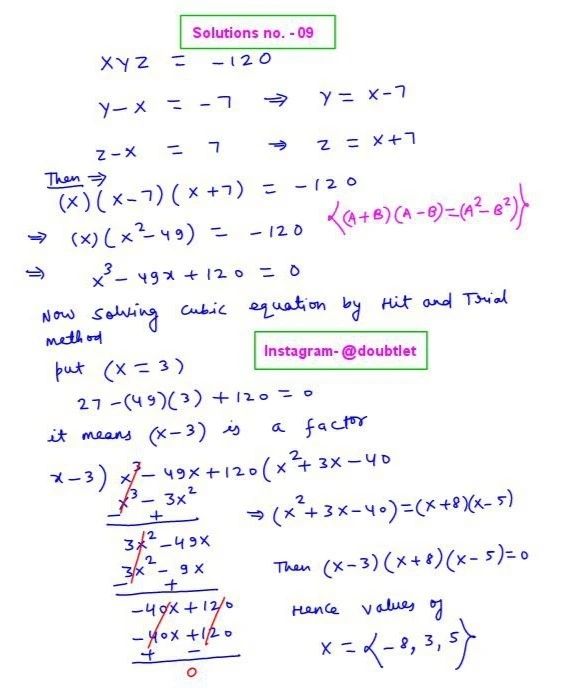









Matrix Characteristic Polynomial: A Complete Guide with Examples
Learn how to calculate the characteristic polynomial of a matrix and understand its significance in linear algebra. Explore step-by-step examples and applications of matrix characteristic polynomials in solving eigenvalue problems and more.The Matrix Characteristic Polynomial is a polynomial derived from a square matrix that reveals its eigenvalues, providing insight into the matrix's properties and behavior. It is found by calculating the determinant of i.e. , where is the matrix and is a scalar. The roots of this polynomial correspond to the eigenvalues of the matrix.

Neetesh Kumar | September 26, 2024
Share this Page on:
![]()
![]()
![]()
![]()
![]()
- 1. Introduction to the Matrix Characteristic Polynomial
- 2. What is Matrix Characteristic Polynomial
- 3. How to Find the Matrix Characteristic Polynomial
- 4. Rules for Matrix Characteristic Polynomial
- 5. Properties of Matrix Characteristic Polynomial
- 6. Matrix Characteristic Polynomial Solved Examples
- 7. Practice Questions on Matrix Characteristic Polynomial
- 8. FAQs on Matrix Characteristic Polynomial
- 9. Real-life Application of Matrix Characteristic Polynomial
- 10. Conclusion
1. Introduction to the Matrix Characteristic Polynomial:
The Matrix Characteristic Polynomial is a key concept in linear algebra that helps in understanding the nature of matrices, particularly in determining eigenvalues. It plays a crucial role in the diagonalization of matrices, stability analysis, and solving systems of linear equations. The characteristic polynomial is directly linked to the matrix’s eigenvalues and offers deep insight into its behavior.
2. What is Matrix Characteristic Polynomial:
The Characteristic Polynomial of a matrix is a polynomial that is derived from the matrix and is essential for determining the eigenvalues. For a square matrix , the characteristic polynomial is defined as:
Where:
-
is a scalar,
-
is the identity matrix of the same size as ,
-
represents the determinant of the matrix .
The roots of this polynomial (i.e., the values of ) are the eigenvalues of the matrix .
3. How to Find the Matrix Characteristic Polynomial:
Step-by-Step Process:
-
Write the Matrix: Begin by considering a square matrix .
-
Subtract : Construct the matrix , where is a scalar, and is the identity matrix.
-
Find the Determinant: Compute the determinant of the matrix . The determinant will give a polynomial in terms of .
-
Express as Polynomial: The resulting expression is the characteristic polynomial of the matrix.
Example:
Consider the matrix . The characteristic polynomial is found by:
Solving the determinant, we get:
4. Rules for Matrix Characteristic Polynomial:
There are several important rules to remember when working with the characteristic polynomial:
-
Square Matrices: The characteristic polynomial can only be calculated for square matrices.
-
Degree of Polynomial: The degree of the characteristic polynomial is always equal to the size (dimension) of the matrix. For example, a matrix will result in a cubic characteristic polynomial.
-
Eigenvalues: The roots of the characteristic polynomial are the eigenvalues of the matrix.
-
Determinant and Trace: The constant term of the characteristic polynomial is equal to the determinant of the matrix, and the coefficient of the linear term (second-highest degree) is the negative of the trace of the matrix.
5. Properties of Matrix Characteristic Polynomial:
Some key properties of the characteristic polynomial include:
-
Invariant Under Similarity Transformations: The characteristic polynomial remains unchanged under similarity transformations, meaning matrices that are similar have the same characteristic polynomial.
-
Determinant and Trace Connection: As mentioned, the determinant of the matrix is equal to the constant term of the characteristic polynomial, and the trace (sum of diagonal elements) is the negative of the coefficient of .
-
Symmetry: The characteristic polynomial will have real roots for symmetric matrices, implying that all eigenvalues are real.
6. Matrix Characteristic Polynomial Solved Examples:
Question: 1. Characteristic Polynomial of a Matrix
Given the matrix:
Solution:
Step 1: Form the Matrix
We first subtract times the identity matrix from the matrix :
Step 2: Find the Determinant of
Now, find the determinant of the matrix :
Step 3: The Characteristic Polynomial
The characteristic polynomial of the matrix is:
Question: 2. Characteristic Polynomial of a Matrix
Given the matrix:
Step By Step Solution :-
A characteristic polynomial of a square matrix is defined as a polynomial that contains the eigenvalues as roots in the form of a polynomial.
It is obtained by using the formula
Where is the identity matrix of similar order as .
Step-1
Final Answer
The characteristic polynomial of the given Matrix
is
Question: 3. Characteristic Polynomial of a Matrix
Given the matrix:
Solution:
Step 1: Form the Matrix
Subtract times the identity matrix from :
Step 2: Find the Determinant of
Find the determinant of :
Step 3: The Characteristic Polynomial
The characteristic polynomial of the matrix is:
7. Practice Questions on Matrix Characteristic Polynomial:
Q.1: Find the characteristic polynomial of the matrix:
Q.2: Calculate the characteristic polynomial of the matrix:
Q.3: Find the eigenvalues of the matrix from its characteristic polynomial:
8. FAQs on Matrix Characteristic Polynomial:
What is the characteristic polynomial of a matrix?
The characteristic polynomial of a matrix is a polynomial that is derived from the matrix and whose roots correspond to the eigenvalues of the matrix.
How do I find the characteristic polynomial?
You can find the characteristic polynomial by computing , where is the matrix, is a scalar, and is the identity matrix.
What is the significance of the roots of the characteristic polynomial?
The roots of the characteristic polynomial are the eigenvalues of the matrix. These eigenvalues reveal important properties of the matrix, such as stability and diagonalizability.
Can non-square matrices have a characteristic polynomial?
No, only square matrices have characteristic polynomials because finding the polynomial requires computing the determinant of a square matrix.
What is the relationship between the characteristic polynomial and the determinant of a matrix?
The constant term of the characteristic polynomial is equal to the determinant of the matrix. The determinant represents the product of the eigenvalues.
What role does the trace of the matrix play in the characteristic polynomial?
The trace of the matrix (the sum of its diagonal elements) is the negative of the coefficient of the second-highest degree term in the characteristic polynomial.
Can all matrices be diagonalized using the characteristic polynomial?
No, only matrices with distinct or sufficient eigenvalues can be diagonalized. However, the characteristic polynomial helps determine whether diagonalization is possible.
9. Real-life Application of Matrix Characteristic Polynomial:
The matrix characteristic polynomial has real-world applications in various fields:
-
Physics: In quantum mechanics, the characteristic polynomial helps find a system's energy states.
-
Control Theory: The characteristic polynomial is used to analyze the stability of dynamic systems in control engineering.
-
Data Science: Eigenvalues and eigenvectors, derived from the characteristic polynomial, are essential in Principal Component Analysis (PCA) for reducing data dimensionality.
-
Economics: Characteristic polynomials are applied in economic models to analyze system behaviors like equilibrium and stability.
-
Computer Graphics: Used in transformation matrices, characteristic polynomials assist in understanding rotations and scaling.
10. Conclusion:
The Matrix Characteristic Polynomial is a fundamental concept in linear algebra that offers significant insights into the properties of matrices. By revealing the eigenvalues of a matrix, it helps in understanding stability, diagonalizability, and matrix transformations. Mastering the characteristic polynomial and its properties is essential for solving complex problems in mathematics, physics, data science, and engineering. Whether simplifying systems of equations or analyzing dynamic systems, the characteristic polynomial provides a powerful tool in understanding matrix behavior.
If you have any suggestions regarding the improvement of the content of this page, please write to me at My Official Email Address: [email protected]
Are you Stuck on homework, assignments, projects, quizzes, labs, midterms, or exams?
To get connected to our tutors in real time. Sign up and get registered with us.
Matrix Eigenvalues & Eigenvectors Blog
Matrix Formula Sheet
Linear Algebra Calculators
Matrix Diagonalization Blog
Matrix Determinants Blog
Blog Information
Blog Author: Neetesh Kumar
Blog Publisher: Doubtlet
Comments(0)
Your comment will be reviewed before it is published.



Leave a comment